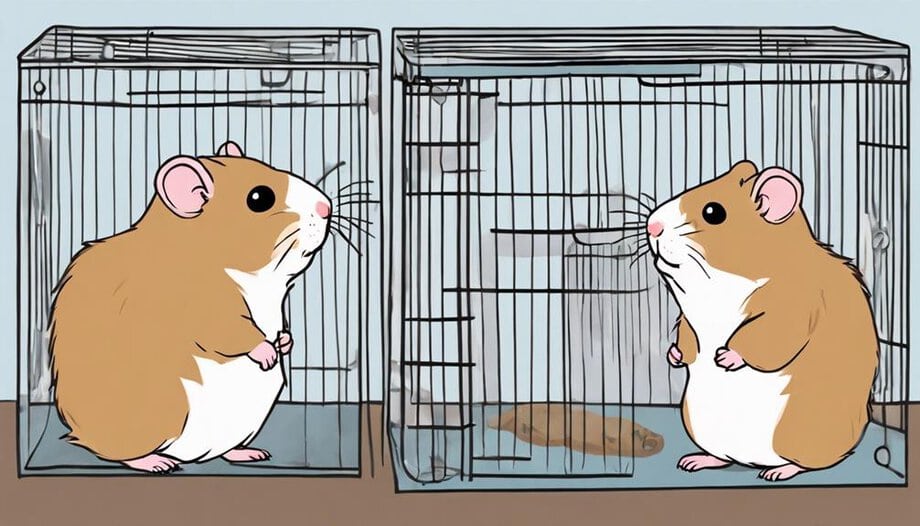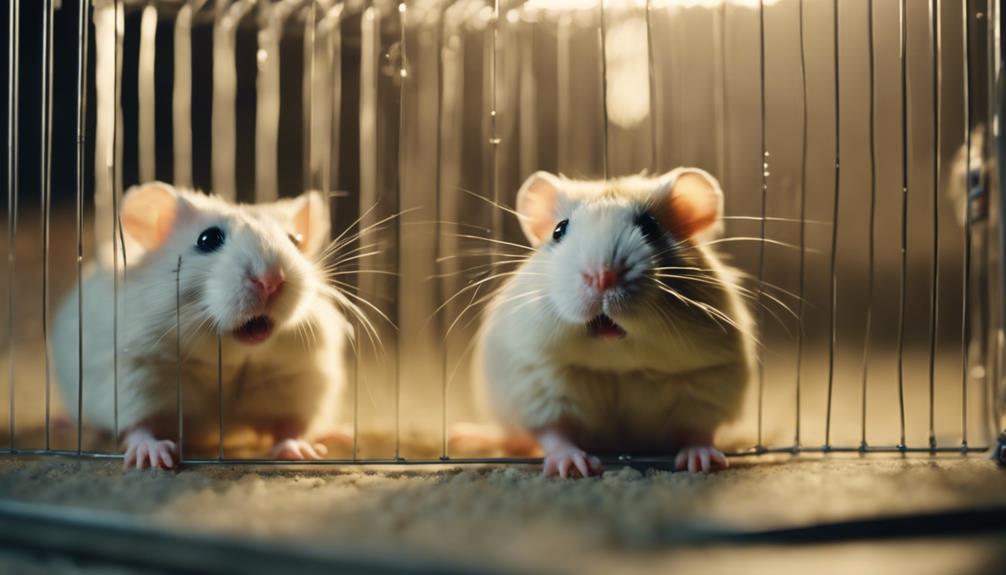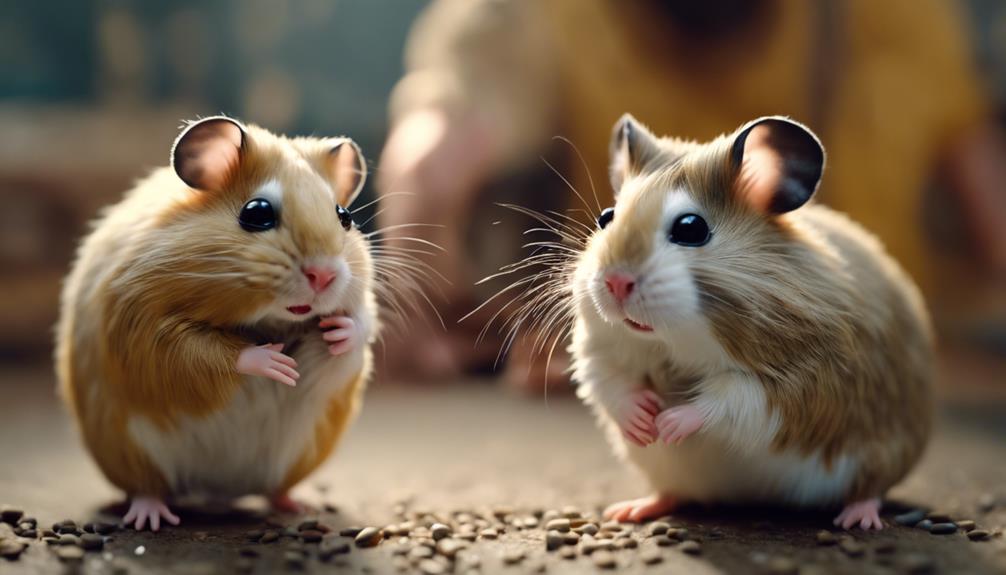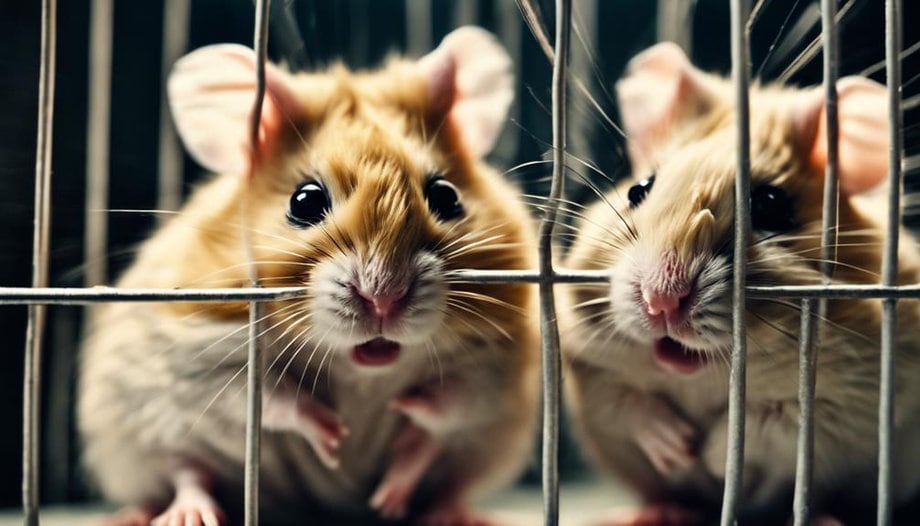What Is the Best Way to Introduce Hamsters to Each Other?

When introducing hamsters to each other, it's important to do so gradually and in a controlled manner. Start by placing their cages near each other so they can get used to each other's scent. Then, you can try swapping bedding or toys between the cages to further familiarize them with each other's scent.
After a few days of this, you can try introducing them in a neutral space, such as a playpen or bathtub. Supervise the interaction closely, and be prepared to separate them if they show signs of aggression.
Keep in mind that not all hamsters will get along, and it's crucial to prioritize their safety and well-being above all else. Remember, patience is key when introducing hamsters to each other.
Understanding Hamster Behavior
Understanding hamster behavior is crucial for successfully introducing them to each other. Hamsters communicate through various behavioral cues, such as grooming, scent marking, and vocalizations. Before attempting to introduce two hamsters, it's essential to observe their behavior individually to gauge their temperament and socialization needs. Some hamsters are more territorial and solitary, while others may be more sociable and open to companionship.
When preparing to introduce hamsters, consider the following socialization tips. Start by placing their cages near each other to allow them to become familiar with each other's scent and presence. Gradually switch their bedding between cages to further acclimate them to each other's smell. Supervised playtime in a neutral space can also help facilitate a positive interaction. It's crucial to monitor their body language during these interactions and be prepared to separate them if any signs of aggression or stress occur.
Preparing Separate Living Spaces
Before introducing hamsters, it's crucial to provide separate living spaces for each of the furry companions. This ensures they have their own safe haven and territory.
Separate Cages Essential
When introducing hamsters to each other, it's essential to prepare separate living spaces to ensure a smooth and safe transition. Here's how to set up separate cages for your furry friends:
- Individual Sanctuaries: Provide each hamster with its own cage equipped with all essentials like bedding, food, water, and toys.
- Safe Distance: Place the cages a good distance apart to prevent any unnecessary stress or territorial behavior between the hamsters.
- Personalized Environment: Tailor each cage to suit the specific needs and preferences of the hamster residing in it, ensuring they feel secure and comfortable in their own space.
Creating distinct living areas for your hamsters will help establish a sense of security for each before moving on to the next steps in their introduction process.
Initial Scent Swapping
To establish familiarity and comfort between hamsters in separate cages, consider initiating scent swapping as a crucial first step in their introduction process. In a controlled environment, begin by swapping bedding or toys between the cages. This allows the hamsters to become accustomed to each other's scents gradually, without direct contact.
By introducing these familiar scents, the hamsters can start recognizing each other's presence and feel less threatened when they eventually meet face to face. This method creates a sense of shared space and can help reduce the likelihood of aggression during their eventual introduction.
Monitor Interactions Closely
Closely monitoring interactions between hamsters in their separate living spaces is essential for ensuring their safety and well-being as they acclimate to each other's presence. Here are three key points to consider when supervising their interactions:
- Behavioral Cues: Pay attention to their body language and vocalizations. Signs of aggression or fear shouldn't be ignored.
- Supervised Interactions: Allow the hamsters to interact under close supervision to intervene quickly if needed and prevent any potential conflicts.
- Separate Spaces: Keep the hamsters in their individual enclosures initially to prevent any direct contact until they show positive behavioral cues towards each other.
Initial Scent Exchange
Introducing a new hamster to another can be facilitated by allowing them to exchange scents initially. Scent familiarity plays a crucial role in the bonding process between hamsters. Before directly introducing them, consider using socialization techniques that involve a gradual approach.
To start the initial scent exchange, swap bedding or toys between the hamsters' enclosures. This allows each hamster to become familiar with the other's scent without direct interaction. The gradual exposure to each other's smells can help reduce stress and anxiety when they eventually meet face to face.
Controlled Visual Introductions

After familiarizing themselves with each other's scents through bedding and toy exchanges, hamsters can now benefit from controlled visual introductions to further ease their eventual face-to-face meeting.
- Observing Behavior: When introducing hamsters visually, observe their behavioral cues closely. Look for signs of aggression, fear, or curiosity. Understanding their reactions can help you gauge their readiness for interaction.
- Utilizing Transparent Barriers: Placing a transparent barrier between the hamsters during their visual introduction can be beneficial. This barrier allows them to see and smell each other without the risk of direct physical contact, providing a safe environment for initial interactions.
- Rotating Enclosures: To further familiarize the hamsters with each other's presence, rotate their enclosures periodically. This allows them to explore each other's scents in the shared space, helping to reduce tension and promote positive visual cues.
Gradual Introduction in Neutral Territory
In the process of bringing hamsters together, it is essential to establish a gradual introduction in neutral territory to facilitate a harmonious interaction. This method allows the hamsters to become familiar with each other's scents and presence, reducing the likelihood of aggressive behavior. By starting their interaction in neutral territory, such as a playpen or a separate cage, the hamsters are less likely to feel territorial and are more likely to engage positively.
When introducing hamsters in neutral territory, it is crucial to observe their behavioral cues. Signs of aggression, such as raised fur, chattering teeth, or chasing, indicate that the introduction may need to be slowed down or halted. On the other hand, if the hamsters show curiosity, sniffing, and grooming behaviors, it is a positive sign that they are comfortable with each other's presence.
To help you understand better, here's a table outlining behavioral cues to look out for during the introduction:
| Positive Behavioral Cues | Neutral Behavioral Cues | Negative Behavioral Cues |
|---|---|---|
| Curiosity and sniffing | Indifference | Aggression and chasing |
| Grooming each other | Exploring the area | Raised fur |
Supervised Playtime Together

When introducing hamsters, it's crucial to create a safe play area for them to interact. Owners should closely monitor their interactions to ensure safety and compatibility.
If any signs of aggression or stress arise, it's important to separate the hamsters promptly.
Safe Play Area
Creating a designated safe play area for hamsters encourages positive interactions during supervised playtime together. Here are three essential elements to consider when setting up this space:
- Secure Enclosure: Use a hamster-proof playpen or a confined space where the hamsters can explore without the risk of escaping.
- Enrichment Items: Provide toys, tunnels, wheels, and other enrichment activities to keep the hamsters engaged and entertained.
- Comfortable Hideouts: Include cozy hideouts or small shelters where hamsters can retreat if they feel overwhelmed, helping them feel safe and secure during playtime.
Monitor Interactions Closely
To ensure a harmonious introduction process, closely monitoring the interactions between hamsters during supervised playtime together is crucial. Behavioral observation plays a key role in understanding the interaction dynamics between the hamsters.
By introducing them slowly and allowing them to bond gradually, you can observe how they communicate, establish hierarchies, and express their boundaries. Pay attention to their body language, vocalizations, and overall demeanor to gauge their comfort levels.
This bonding process isn't only essential for their well-being but also for building a strong relationship between the hamsters. By actively supervising their playtime, you can intervene if necessary and ensure that the interactions remain positive and enriching for both furry companions.
Separate if Needed
If there are signs of aggression or tension between the hamsters during supervised playtime together, it's wise to separate them temporarily to prevent any potential conflicts. Here are three key points to consider during this crucial step:
- Behavior Observation: Watch closely for any aggressive behavior, such as biting, chasing, or excessive mounting. These signs indicate that the hamsters may not be ready for extended playtime together.
- Safe Introduction Techniques: When reintroducing the hamsters, consider using neutral territory and providing plenty of hiding spots and resources to prevent territorial disputes.
- Supervised Playtime: Always supervise the hamsters during their interactions to ensure a quick response in case tensions escalate. Remember, their safety is paramount, and a watchful eye can prevent any potential harm.
Signs of Aggression or Stress

When introducing hamsters to each other, it's crucial to be able to recognize signs of aggression or stress in order to prevent potential conflicts. Body language plays a significant role in understanding how hamsters might be feeling towards each other. Warning signs such as raised fur, lunging, or biting indicate aggression and the need for immediate separation.
Stress indicators are equally important to consider during introductions. Behavioral cues like excessive hiding, over-grooming, or aggressive vocalizations can all point towards heightened stress levels in hamsters. If these signs persist, it's essential to address the situation promptly to ensure the well-being of the animals.
Seeking Professional Advice if Necessary
Recognizing the importance of a harmonious introduction between hamsters, seeking professional advice can provide invaluable guidance in navigating any complexities that may arise during the process. When considering professional guidance, behavioral experts can offer insights tailored to your specific hamsters' temperaments and behaviors.
These experts can observe the hamsters' interactions and provide personalized recommendations to ensure a smooth introduction. Socialization tips from these professionals can include gradual introductions in a neutral territory to prevent territorial disputes. Moreover, introduction techniques such as scent swapping and supervised playtime can help foster positive associations between the hamsters.
Frequently Asked Questions
Can Hamsters of Different Species Be Introduced to Each Other?
When considering introducing hamsters of different species, behavioral observations are crucial. Interspecies compatibility varies, and social hierarchy dynamics may impact success. Careful housing arrangements, gradual introductions, and close monitoring are key for a harmonious integration.
How Long Should the Initial Scent Exchange Process Last Before Moving on to Visual Introductions?
In the delicate dance of scent exchange, the enchanting aroma lingers, teasing with anticipation. Visual intros, the second act, unveil the mystery. Patience is key, for in the quiet moments, true bonding opportunities arise, crafting lifelong connections.
What Should I Do if My Hamsters Show Signs of Aggression During the Introduction Process?
If hamsters show aggression during introduction, separate them immediately. Use calming techniques like soothing music or dim lighting. Monitor progress closely for behavioral changes. Slowly reintroduce them, observing for signs of aggression and adjusting accordingly.
Is It Possible for Hamsters to Become Friends After Being Introduced, or Will They Always Be Territorial?
Hamsters can form deep bonds after being introduced, with patience and the right bonding techniques. Trust building is key for socialization benefits and positive behavioral changes. Overcoming initial territorial instincts is possible for lasting friendships.
How Can I Tell if My Hamsters Are Stressed During the Introduction Process, and When Should I Seek Professional Advice?
During the introduction of hamsters, it's crucial to pay attention to stress indicators like excessive hiding or aggression. If behavioral changes persist, seeking professional advice is wise. Timely intervention can prevent potential conflicts and ensure a smoother introduction process.









